Light bulbs are a common yet remarkable invention that light up our homes, offices, and streets. At the heart of a light bulb’s functionality are electrical components that interact to produce light. The most visible part of a light bulb is the glass enclosure, which not only protects the inner parts but also allows light to pass through. Within this glass globe, there are several components, each playing a critical role, and it all starts with the conductors. Conductors within a light bulb are responsible for delivering electric current to the filament—the thin wire that glows when heated.
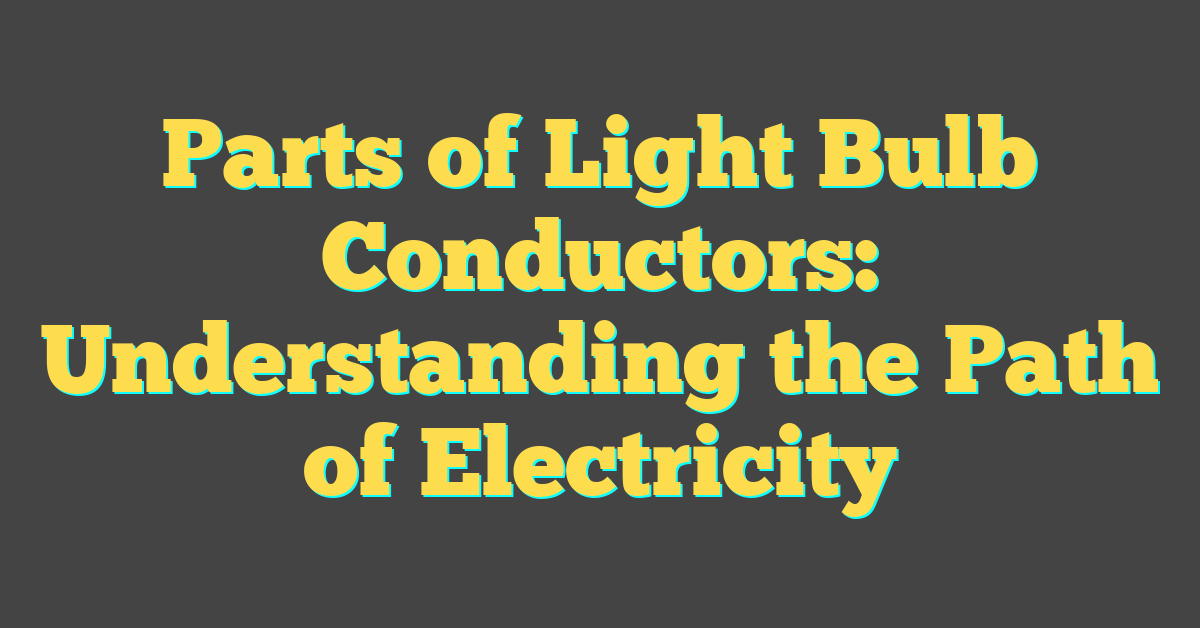
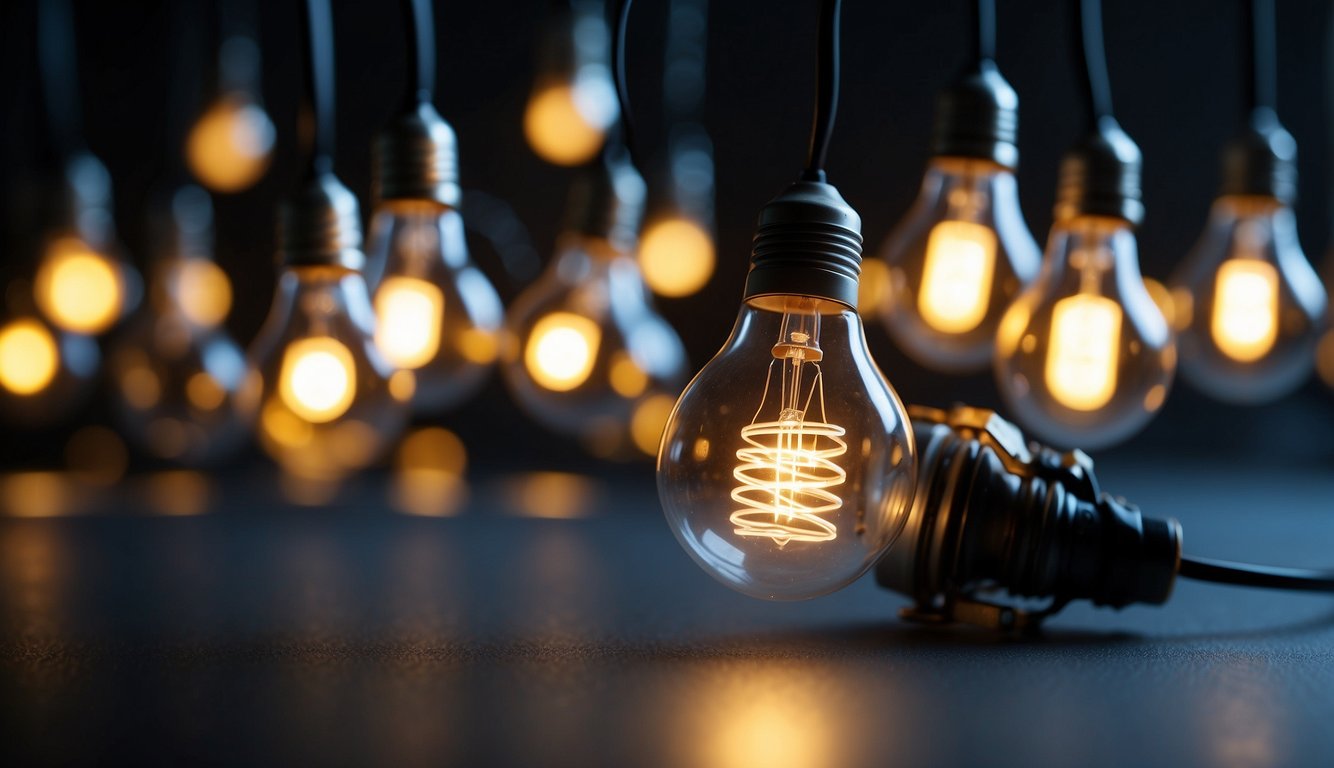
The basic structure of a light bulb conductor involves a tightly coiled metal filament, usually made of tungsten, connected to a metal base through a pair of electrical wires. Tungsten is used because of its high melting point and ability to emit light when an electric current flows through it. These conductors are surrounded by an inert gas that prevents the filament from oxidizing and breaking. Understanding how these parts work together not only illuminates the bulb’s operation but also the underlying principles of electrical conductivity and the importance of protective environments for delicate components.
Key Takeaways
- Conductors in light bulbs are crucial for transmitting electricity to the filament.
- Tungsten filaments emit light when heated by an electrical current.
- The inert gas within the bulb prolongs the filament’s life span by preventing oxidation.
Basics of a Light Bulb
https://www.youtube.com/watch?v=YnMP1Uj2nz0&embed=true
When you think of a light bulb, a few key components come to mind. Traditionally, the classic incandescent light bulb consists of a glass bulb that encloses a filament supported by a metal base, which connects to your electrical circuit when installed.
Main Components:
- Glass Bulb: This is what you see first! It’s typically clear or frosted glass, designed to protect the inner parts while letting light through.
- Filament: Found at the heart of the bulb, usually made of tungsten, this is the part that glows bright when electricity flows through.
- Metal Base: This is the bottom of the bulb that screws into your lamp or socket. It ensures the bulb has a stable electrical connection.
Inside the glass bulb, there’s an inert gas like argon, which helps prolong the life of the tungsten filament. When you flick the switch, electricity travels through the base, heating up the filament until it’s white-hot, and that’s what produces light.
Remember, the key to a bulb’s function is how these parts work together. The metal base forms the foundation, while the glass bulb shelters the sensitive filament from the outside environment, and the presence of inert gas keeps things from burning out too quickly.
Electrical Components
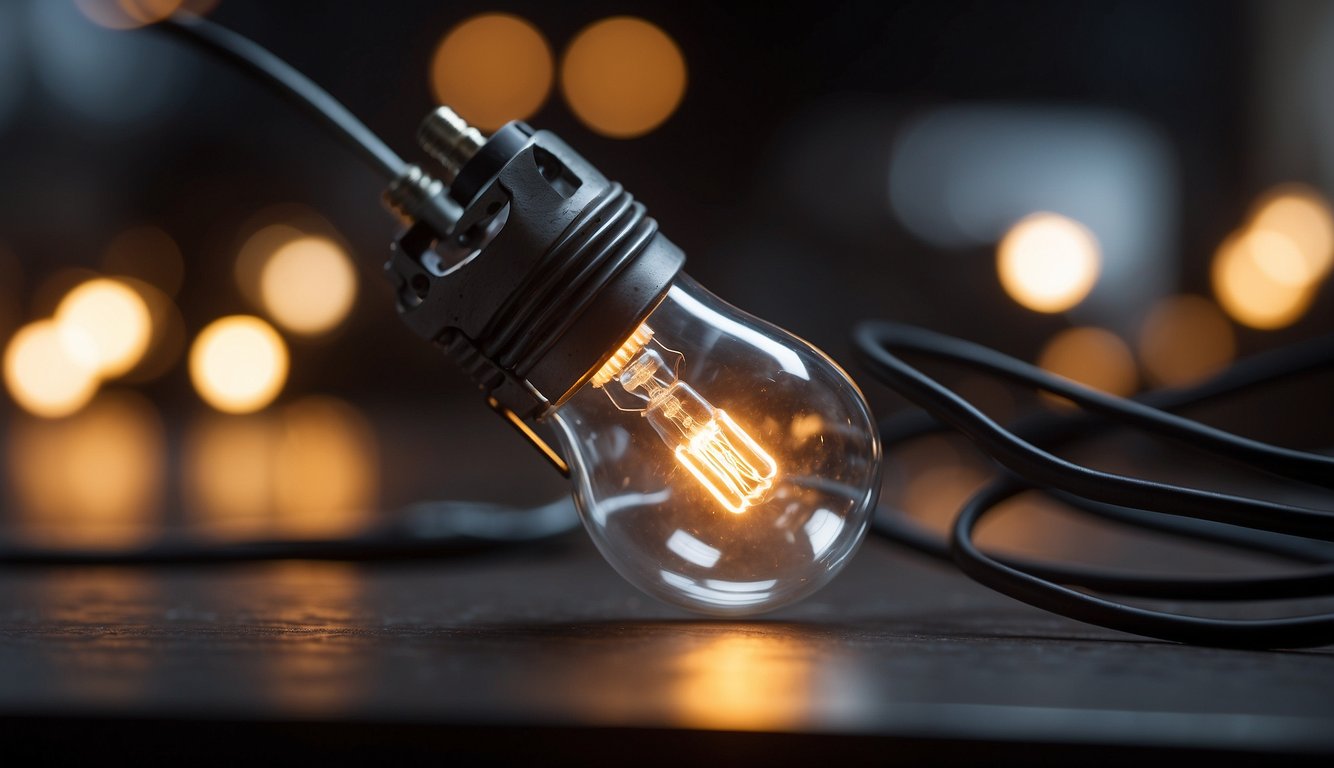
In the heart of every light bulb, electrical components work synergistically to illuminate your space. You’ll find the filament, act as conduits for electricity, all housed within a protective environment.
Filament
The filament is crucial for producing light. Typically made of tungsten, a material with high melting point, it heats up when electricity passes through, creating light. The filament’s resistance to the flow of electrons is what makes it glow.
Conductors
Conductors, often made from metal, such as copper or aluminum, allow for the efficient flow of electrical current. Within the light bulb, metal contacts and wires connect the power source to the filament, forming an electrical circuit.
Insulators
Insulators, such as the glass stem inside the bulb, are materials with high resistance that prevent the undesired flow of electricity. They ensure that electrons travel where they’re needed and help protect against electrical shorts.
Conductivity in Bulbs
https://www.youtube.com/watch?v=4WillWjxRWw&embed=true
When you flick a switch, the conductors in a light bulb work silently to illuminate your room. These conductors are crucial for directing electricity through the bulb to produce light.
Metal Conductors
Metal conductors are the key players inside light bulbs. They consist mainly of copper and iron, which allow for efficient transmission of electric current due to their low resistance and high conductivity. Copper, found in the wires connected to the bulb’s base, swiftly carries electrical current to the filament. Learn about the light bulb structure and light bulb parts.
Insulating Materials
« Worst Type of Light Bulb: What You Should Avoid for Eco-Friendly Lighting
Light Bulbs Instead of Candles: Embracing Modern Illumination »
While conducting materials like metals are vital, insulating materials play the opposite role. They prevent the unwanted flow of electricity, maintaining safety and functionality in the bulb. The glass globe of the light bulb also ensures maximum light efficiency and acts as an insulator to protect the inner parts of the bulb.
Anatomy of the Bulb
https://www.youtube.com/watch?v=txiCd7xPz_k&embed=true
When you look at a light bulb, you’re seeing more than just a bright source of light. You’re observing a carefully designed object made of several parts, each with its unique function. The glass envelope and base with its contacts are two key components essential to the bulb’s design and operation.
Glass Envelope
The glass envelope, or glass globe, serves as a durable cover that protects the delicate internal parts of your bulb. It’s crafted from glass, a material chosen for its ability to withstand high temperatures and its transparent quality, allowing light to pass through unimpeded. This part of the bulb ensures that the light is distributed evenly across your room.
Base and Contacts
At the other end of the bulb, you’ll find the base, which is typically made from metal. This is the section that screws into your light fixture’s socket. Within the base, metal contacts are precisely positioned to allow electrical current to flow into the bulb when it’s placed in the socket. These metal contacts connect to the bulb’s internal wiring, completing the circuit needed to produce light. Look closely and you’ll see that these contacts often take the form of small metal pins or tabs, which ensure a secure connection with the power source.
Supporting Structures

In any light bulb, robust supporting structures are crucial to maintain the integrity and functionality of the delicate internal components. These supports are often constructed from metals known for their durability, like steel, ensuring that the filament is precisely positioned and secure.
Stem
The stem in a light bulb is a glass mount that holds the filament and the support wires in place. It’s the central backbone of a bulb, anchoring the internal parts to the metal base. This stem is essential because it provides a steady support system that prevents the movement of the filament, which could lead to a breakage and the bulb’s failure.
Support Wires
Support wires are thin yet strong metallic strands, typically made from resilient metals like steel, designed to hold the filament in place within the bulb. These wires ensure that the filament remains taut and centered during operation. By doing so, they help maximize the lifespan of your light bulb by minimizing the risk of damage due to vibrations or shocks.
Powering the Light Bulb
To illuminate a light bulb, you need to supply it with electrical energy and connect it to a circuit. Let’s explore how these crucial components work together to bring light to your space.
https://www.youtube.com/watch?v=gmyGKIprpBQ&embed=true
Electrical Supply
Your light bulb requires a consistent and stable supply of electricity to function. You typically get this supply from the mains at your home, which delivers alternating current (AC) to power your fixtures. However, sometimes you might use a battery or a cell—like in portable or emergency lighting—which provides direct current (DC) as a power source.
Connecting to Circuit
For a light bulb to light up, it must be properly connected to a circuit with connecting wires. The circuit’s design ensures that electric current flows through the bulb’s filament. If you’re setting up a light bulb, you need to make sure the connecting wire is securely attached to both the contact on the base of the bulb and to the power supply, completing the circuit and allowing your light bulb to shine.
Safety Features
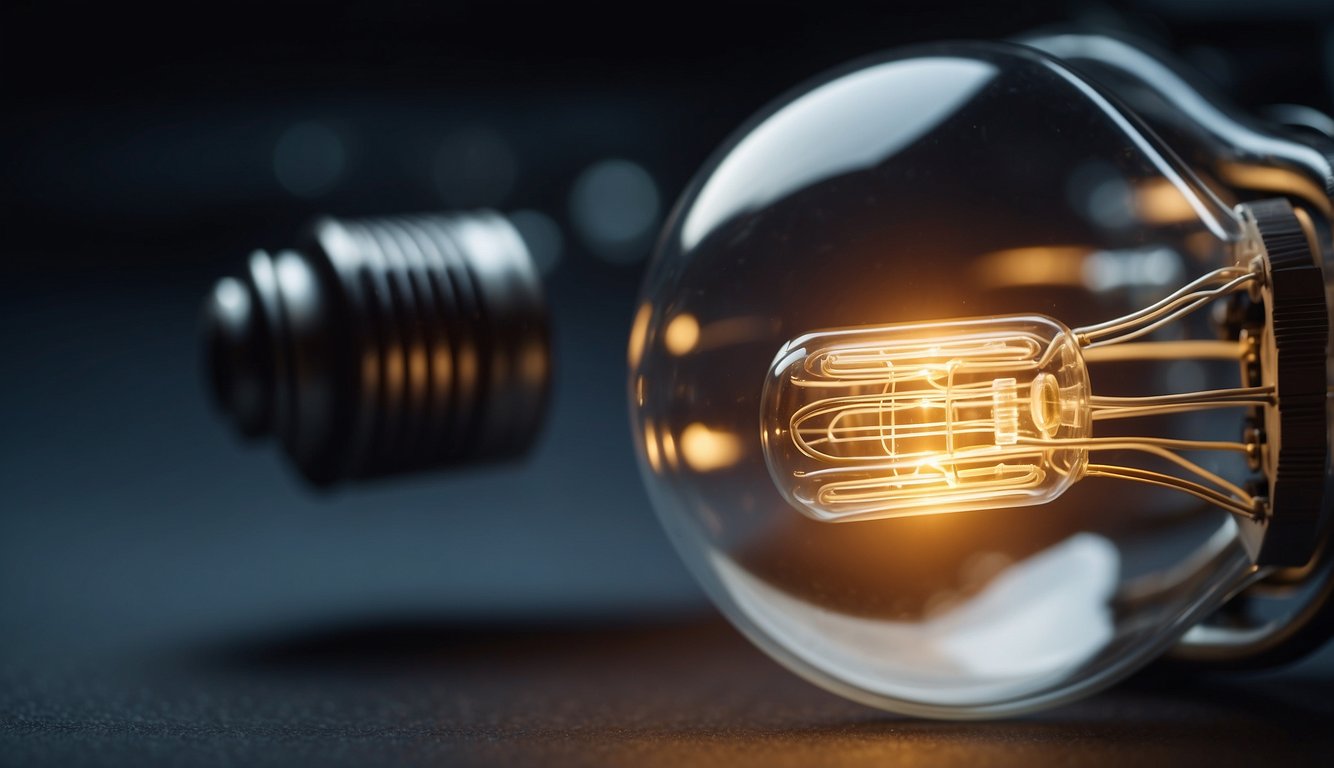
In light bulb construction, safety is paramount, and certain parts are specifically designed to protect you from electrical shock. Materials such as plastic, rubber, and wood are often used because of their insulating properties. These materials prevent the conductive parts from being exposed, reducing the risk of accidents.
Insulators Surfaces
Your light bulb has surfaces made from insulating materials like plastic or rubber. These materials are poor conductors of electricity and are used to form a barrier between the electrical components and your touch. This is crucial as they minimize the chances of an electrical shock when you handle or change a light bulb. For instance, the metal base of the light bulb, while necessary for electrical contact, is often encased in plastic to ensure your safety.
Covering
The covering of a light bulb serves both a protective and functional purpose. The outer glass, also known as the globe, is another form of insulation that safeguards against direct contact with the metal filament inside the bulb. Here’s a quick overview:
- Globe: Encases the filament, preventing direct contact.
- Base Cover: Typically made from insulating materials to avoid electrical hazards.
The design of these coverings ensures that the delicate and potentially dangerous components remain inaccessible during regular use, further securing your safety when interacting with light bulbs.
Types of Light Bulbs
https://www.youtube.com/watch?v=EVOwTXHNX7E&embed=true
When you’re looking to light up your space, you have a variety of light bulbs to choose from. Each type offers different benefits and uses, and knowing these can help you make an informed decision for your home lighting needs.
Incandescent Bulbs
Incandescent bulbs are your traditional option and work by passing electricity through a tungsten filament. The electricity heats the filament until it glows, producing light. These bulbs are known for their warm, inviting glow and are often a cost-effective choice with a simple design that works on both alternating or direct current. However, they tend to have a shorter lifespan and are less energy-efficient compared to other types.
LED Bulbs
LED bulbs, or light-emitting diodes, are a more modern lighting solution that uses a semiconductor to convert electricity into light. Your LED options are incredibly energy-efficient and boast a much longer lifespan than incandescent bulbs. Not only do they consume less power, but they also produce very little heat, making them a safer and more sustainable choice for your home.
The Role of Inert Gas
https://www.youtube.com/watch?v=98s7VHcNXaY&embed=true
When you’re dealing with the inner workings of a light bulb, understanding the role of an inert gas is crucial. These gases, such as argon, play a pivotal part in the longevity and functionality of the bulbs you use every day.
- Prevents Oxidation: First and foremost, inert gases prevent the delicate tungsten filament from interacting with oxygen. If oxygen were present, your light bulb’s filament would simply burn up.
- Conducts Heat: Besides protection, inert gas actually helps by conducting heat away from the filament. This helps manage the temperature within the glass bulb to prevent it from getting too hot.
Argon is typically the gas of choice due to its non-reactive nature and cost-effectiveness. Here’s what happens when electricity is introduced to the mix:
- Electricity flows.
- Argon kicks in, creating an environment where the filament can safely get to work, illuminating without burning out prematurely.
- Heat generated by the filament is distributed, thanks to the noble characteristics of inert gases.
By understanding these principles, you can see why inert gases like argon aren’t just filling space – they’re safeguarding your light bulb’s life.
Handling and Maintenance
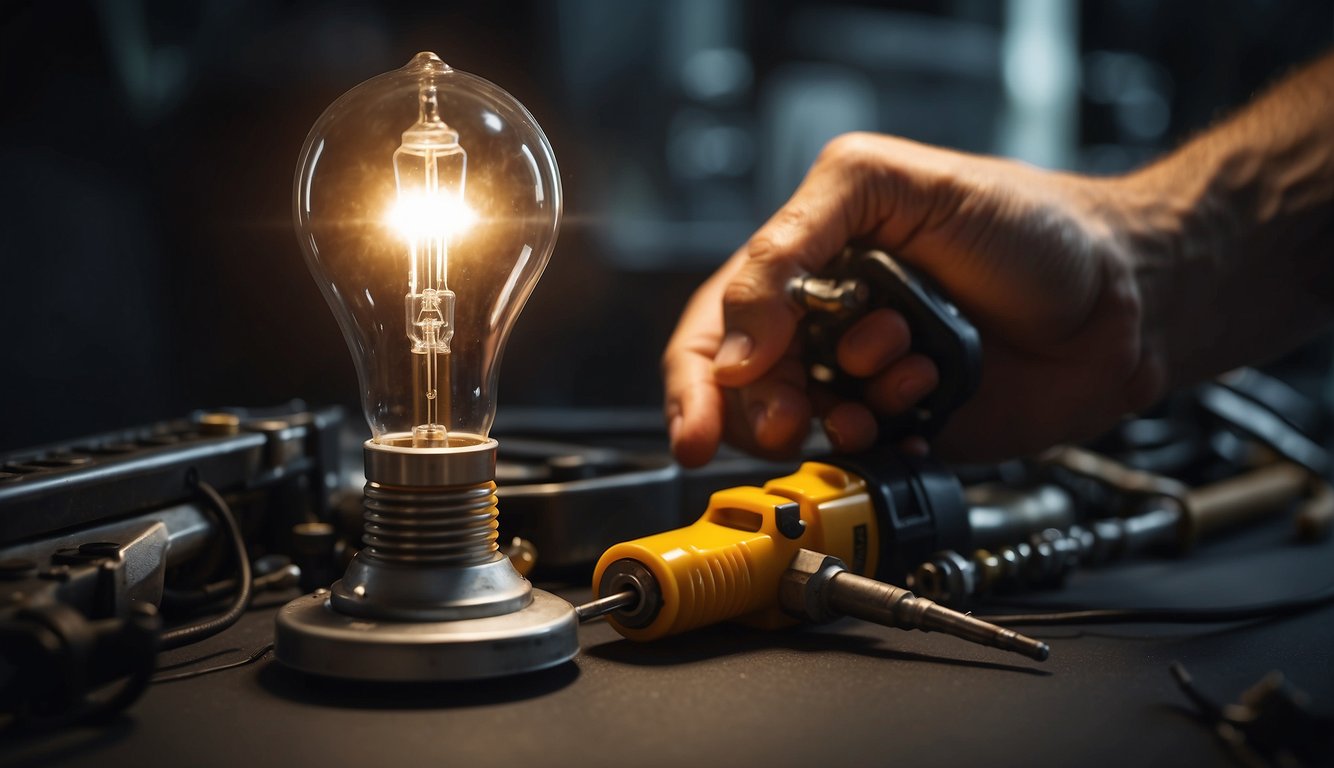
When you’re dealing with light bulbs, handling them with care is paramount. The glass bulb is fragile and can easily break if dropped or handled roughly. Always grasp the bulb by its base, and when screwing in, apply gentle pressure to avoid cracking the glass.
Before Maintenance:
- Ensure that the power supply is turned off to prevent electrical shock.
- Allow the bulb to cool down after use; the glass bulb can be very hot.
During Maintenance:
- Use a soft cloth when cleaning the glass bulb to avoid scratches.
- Do not use water or liquids, especially when the bulb is hot, as it may shatter.
After Replacement:
- Dispose of the old bulbs properly. Incandescent bulbs can go in regular waste, but more eco-friendly recycling options may be available for other types.
- Check that the new bulb is secure in the socket but avoid over-tightening.
Safety Tips:
- Wear gloves to protect your hands from both sharp edges and dirt, which can shorten the bulb’s lifespan.
- If you’re replacing a bulb in a lamp with a covering or shade, make sure the covering is properly refitted to avoid the risk of it falling or causing overheating.
- Always follow the manufacturer’s guidelines for the wattage and type of bulb suitable for your lighting fixture.
By taking the time to handle and maintain your light bulbs correctly, you ensure your safety and extend the life of the bulbs. Remember to always prioritize your safety by using the appropriate precautionary measures.
Disposal and Recycling

When the time comes to say goodbye to your light bulb, proper disposal and recycling are key to ensuring environmental safety. Light bulbs consist of metals, glass, and sometimes plastic, which can require specific disposal methods.
- Metals: The metal components can be recycled. Recycling centers often accept these because of their value and recoverable status.
- Glass: This can also be recycled, but the process varies depending on the type of bulb you’re recycling.
- Plastic: If your light bulb has plastic parts, these should be separated and recycled according to your local recycling guidelines.
Remember, the following bulb types need special attention:
- CFLs (compact fluorescent lamps): Since these contain a small amount of mercury, they should be taken to a specialized recycling facility.
- LEDs: These bulbs are a bit easier to handle and can often be recycled at local waste facilities.
Here’s a simple guide to help you:
- Check if your local waste management facility accepts light bulbs for recycling.
- If recycling isn’t an option, consider if the bulb’s packaging indicates any specific disposal instructions.
- For bulbs containing hazardous materials, locate a nearby drop-off site for safe disposal.
Do not throw light bulbs containing hazardous materials into regular trash. Your small effort in proper disposal makes a big difference in environmental protection.




